- #1 – TekPower Analog Display TP30SWI
- #2 – Pyramid PSV300
- #3 – TekPower TP350
In the world of HAM radio enthusiasts, a reliable power supply isn’t just a component—it’s the heart of your setup.
Ever wonder what keeps your transmissions clear and your signals strong, regardless of the weather or time of day? The answer lies in the power supply.
These vital devices convert mains AC to low-voltage regulated DC power, ensuring your HAM radio operates at its best.
Whether you’re making local contacts on a 2-meter band or reaching across continents on the HF frequencies, the right power supply can make all the difference.
Today, we spotlight the top HAM radio power supplies that have proven their worth in performance and reliability. Join us as we unveil the top three powerhouses behind your passion for amateur radio.
#1 – TekPower Analog Display TP30SWI
The TekPower Analog Display TP30SWI is an old-school analog power supply that looks sharp on your desk. It measures 7.5 inches wide, 7.5 inches deep, and 2.8 inches tall, and tips the scales at six pounds.
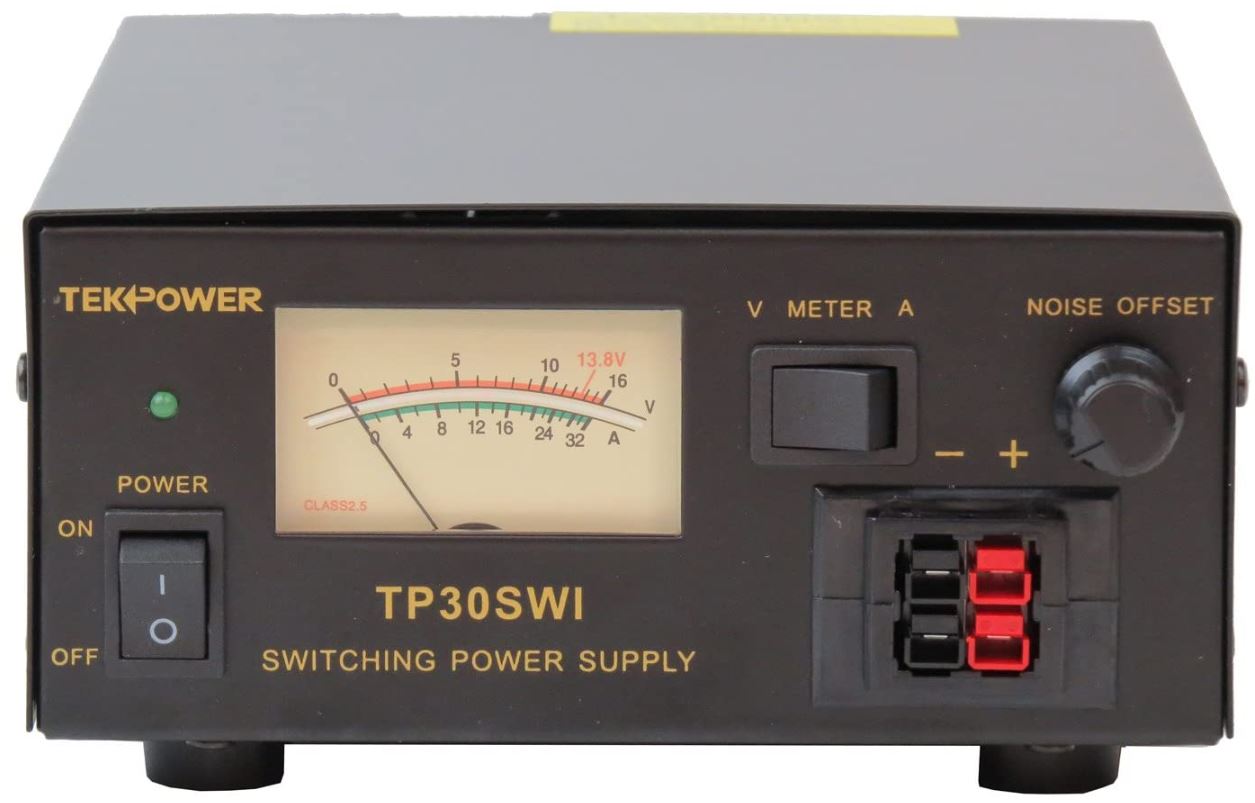
The case is constructed from a dark brown aluminum, with retro gold text on all the indicators. On the front, there’s an analog gauge that can display either voltage or amperage.
To the right of the gauge, you’ll see a small switch that can toggle between volts and amps. To the right of that switch, there’s a noise offset dial. This dial is for reducing RFI. If your power supply starts interfering with your transmission, just play with the dial until it goes away.
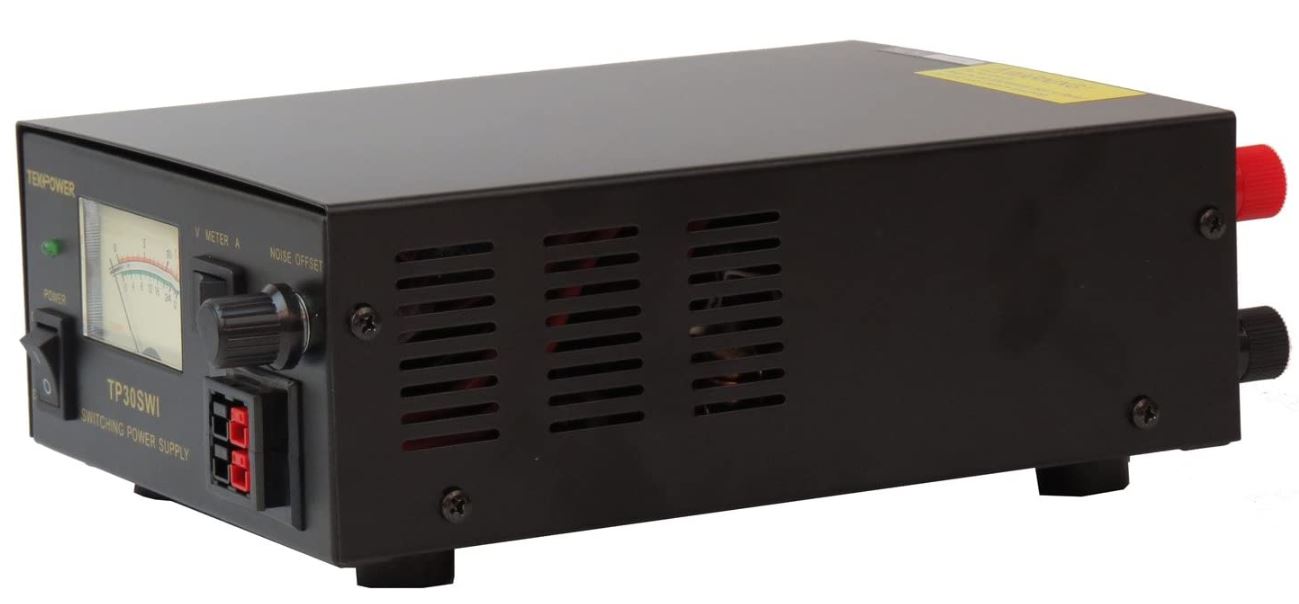
Beneath the RFI dial, there’s a four-prong connection for more modern radio transceivers. On the back, there’s two terminal binding posts. On the front, there’s a pair of Anderson power poles that support old-school connections. There’s also a power switch and power light to complete the package.
In terms of performance, it works very well. The line and load regulation are excellent, so you won’t see a lot of variation in the current. Moreover, it produces very little RFI. And if you do experience any interference, the dial will virtually eliminate it.
Keep in mind that the RFI will depend on what frequency you’re listening on. So it can sound fantastic at one frequency, then develop static when you switch bands. Thankfully, you can just readjust the dial when you switch frequencies.
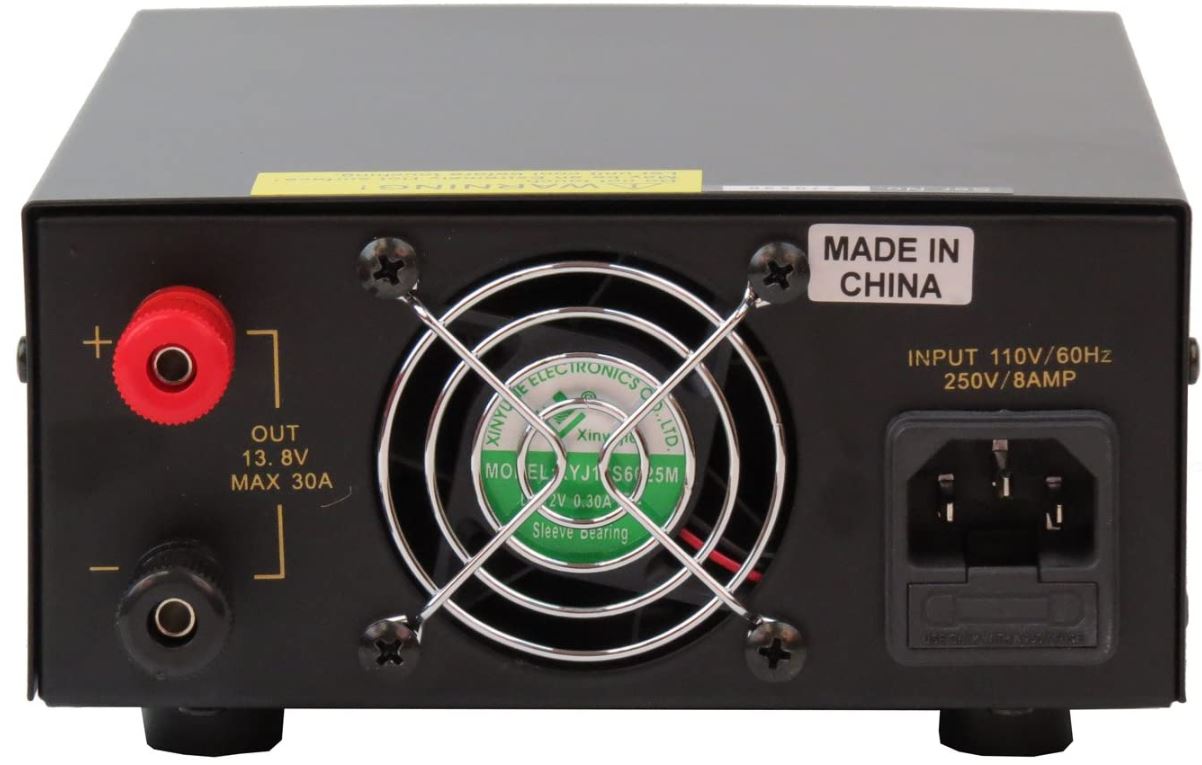
In addition to the power supply itself, you get an AC cord to plug it into your wall. You also get a TekPower warranty card. Make sure to fill this out and send it in so you can get your warranty coverage. The warranty is valid in the US only, and covers you for 12 months for manufacturing defects.
Technical Specifications
If you’re already a HAM radio expert, here are the basic features you need to know.
- 30A intermittent current
- 20A continuous current
- 13.8V DC fixed output
- Noise offset
- 120V AC input
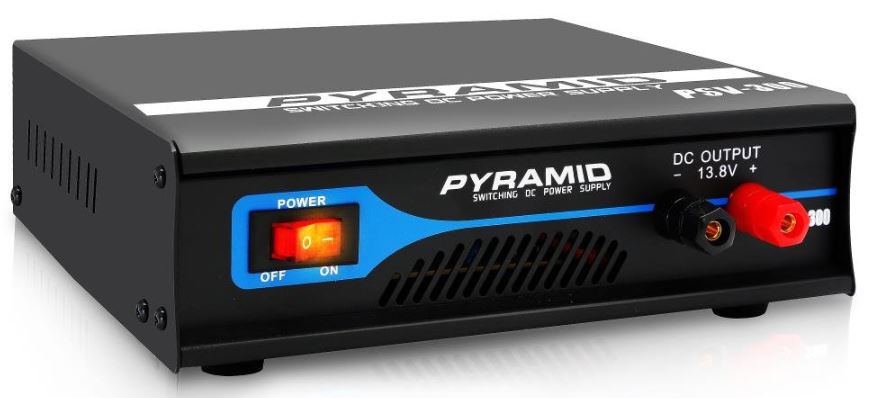
#2 – Pyramid PSV300
The Pyramid PSV300 is a more affordable power supply that provides most of the same features. It’s constructed from black anodized aluminum, and measures 8.5 inches deep, 8.3 inches wide, and 2.6 inches tall.
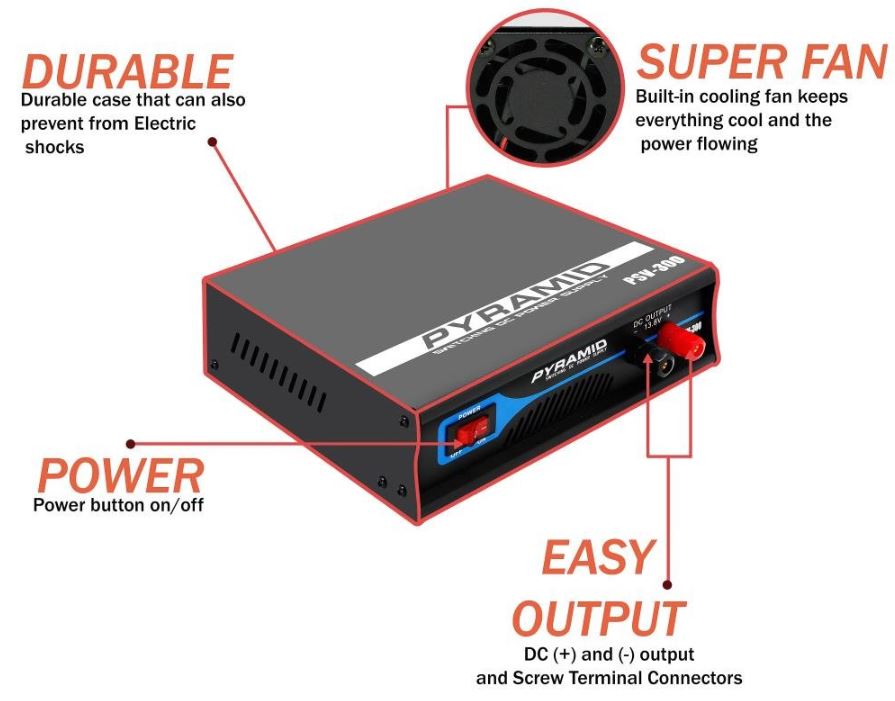
At six pounds, it’s a bit heavy, but rubber feet on the bottom keep it from scratching your desk. On the front left, there’s an orange power switch that lights up when the power supply is active.
On the front left, you’ll find a simple two-plug connection for the power output. The terminals are hardwired, and they feature large plastic screws for easy operation.
The power cord is attached to the back of the machine, and there’s also a voltage selection switch. This switch can be used to toggle between a 120-volt and a 230-volt AC input. As a result, you can use the PSV300 just about anywhere in the world. You’ll just need a plug adapter for your region.
The circuitry features all the safety features you’d expect from a modern power supply. It provides overload protection and short circuit protection to keep your transceiver safe. Moreover, you’ll also find a USB port on the front of the unit. So even while you’re using old-school radio technology, you can keep your smartphone charged.
One downside of the PSV300 is that it doesn’t have any noise offset. As a result, you might experience some moderate static due to RFI. This will depend entirely on what band you’re listening to. On some bands, the signal is perfectly clear, without any major issues. On other bands, you’re going to hear some static.
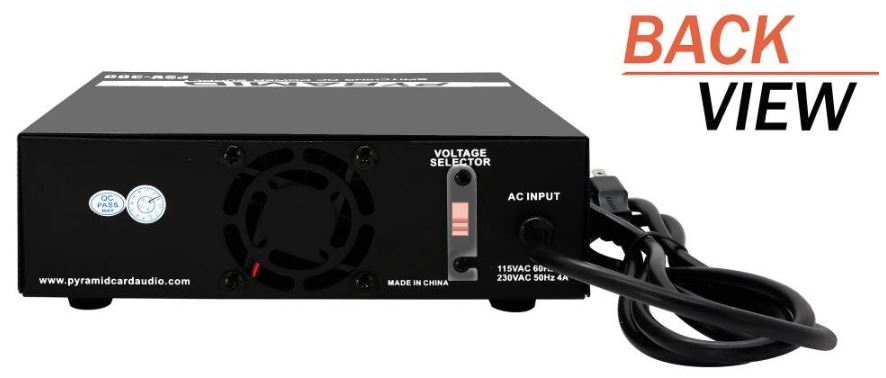
Technical Specifications
So, you’re an expert, and you just want to get to the specs? Here’s what you need to know.
- 30A intermittent/continuous current
- 13.8V DC fixed output
- No noise offset
- Built-in USB charging port
- 120V or 230V AC input
#3 – TekPower TP350
Unlike the last two power supplies on our list, the TekPower TP350 is designed for automotive or RV use. This isn’t to say you can’t use it in your home. It has an AC power input along with a power cord for this purpose. But it also sports a 12-volt DC input for use in your car, truck, or RV.
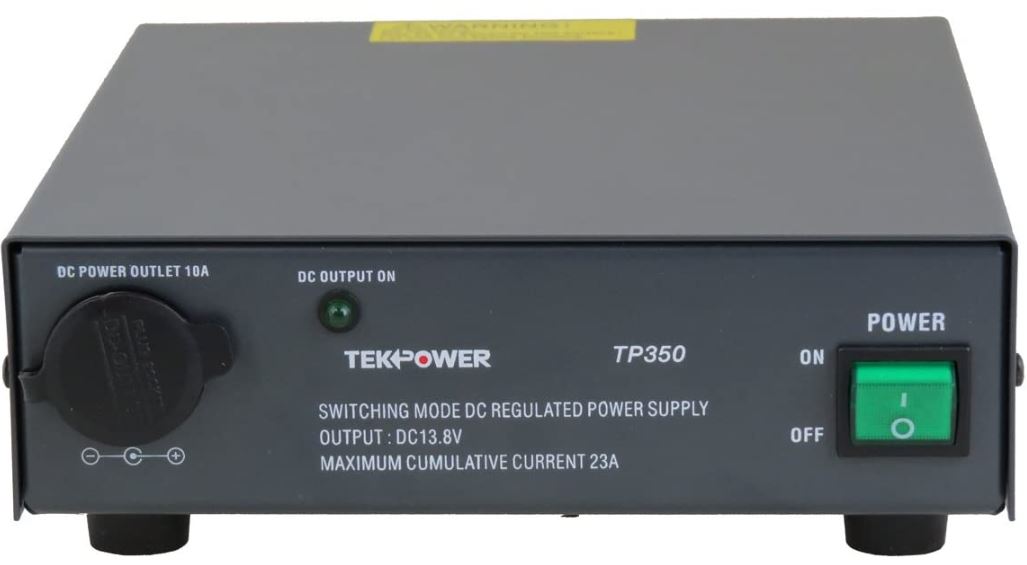
In addition, it includes a pair of mounting brackets that make it easy to install. The unit itself is smaller than the last two, measuring 7.5 inches deep, 7 inches wide, and 2.5 inches thick. It also weighs only four pounds, so it’s easy to install in your vehicle.
The case is constructed from black anodized aluminum, and is sturdy enough to withstand vibration. On the front left, you’ll find the DC power input, which has a black plastic cover. You’ll also find a green, light-up power switch.
On the back, you’ll see the AC input to the left, and a pair of screw-down connections to the right. Along with the power supply, you also get a warranty registration card. Fill this card in and mail it, and you’ll get a 12-month manufacturer’s warranty.

The RFI is relatively low. However, you’ll need to install a ground cable to make this happen. Unfortunately, TekPower decided to secure the grounding screw with thread lock. To loosen it, you’ll need to open the case, which involves removing six screws.
Then you’ll be able to get the screw loose and attach your ground cable. If RFI is a major concern for you, it’s well worth the effort. On the other hand, if you’re not bothered by static, you might want to just leave it be.
Technical Specifications
For those of you who are just skimming, here’s the bare minimum.
- 23A intermittent current
- 20A continuous current
- 13.8V DC fixed output
- 12V DC input or 120V AC input
Final Verdict
So, how do these HAM radio power supplies compare? It depends what you need, and what you’re willing to spend.
To begin with, we looked at the TekPower Analog Display TP30SWI. This is a premium power supply that’s best if you’ve got plenty of dough to spend. It’s easy to set up, it’s sturdy, and the retro design looks beautiful. Moreover, the noise reduction dial makes it easy to get a clear signal.
Next, we looked at the Pyramid PSV300. This more affordable option can create some noise. On the other hand, there are some useful features.
First off, it’s more powerful than the TekPower power supplies, providing a full 30 amps. It’s also compatible with 230-volt power systems from around the world. If you live outside North America, it’s a better choice.
Finally, we reviewed the TekPower TP350. This is a great power supply for installing in your vehicle. It also provides the best RFI protection, provided you’re willing to do the work. And it’s reasonably priced, so you won’t have to spend a fortune on your power supply.
Meet Ry, “TechGuru,” a 36-year-old technology enthusiast with a deep passion for tech innovations. With extensive experience, he specializes in gaming hardware and software, and has expertise in gadgets, custom PCs, and audio.
Besides writing about tech and reviewing new products, he enjoys traveling, hiking, and photography. Committed to keeping up with the latest industry trends, he aims to guide readers in making informed tech decisions.

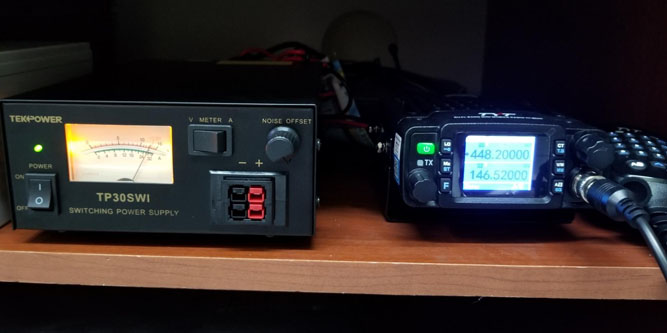
Are those Baofeng uv5r good enough to start with is it worth the time to hook it up to an outside antenna also your opinion of this Baofeng radio. Thanks
Thank you. This fine article and lets me begin to think of a digital power supply as something I really need to explore. My conerns about RFI have in the past kept me from moving off the analog path.
Do you have any experience with the RigRunner line? Several friends are highly complimentary but I have read no independent reviews.
Regards,
Tony N7KQC
I have a Pacemaker/ defibulator what do I need to be concerned with